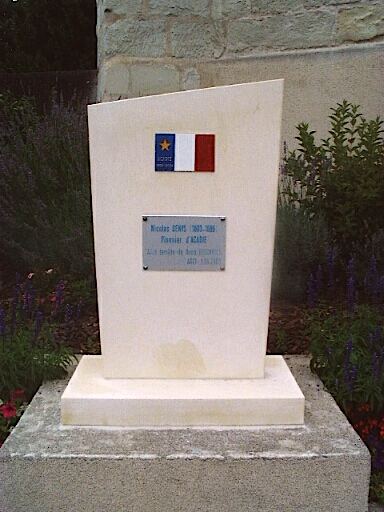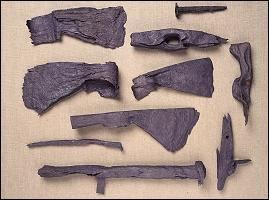Name Nicolas Denys | Died 1688, Bathurst, Canada | |
 | ||
Books The description and natural history of the coasts of North America (Acadia) | ||
*Human Skin Covered Book - Anthropodermic bibliopegy - St.Peter's, Nova Scotia
Nicolas Denys (1598? – 1688) was a French aristocrat who became an explorer, colonizer, soldier and leader in New France. Today, he is perhaps best known for founding settlements at St. Pierre (now St. Peter's, Nova Scotia), Ste. Anne (Englishtown, Nova Scotia) and Nepisiquit (Bathurst, New Brunswick).
Contents
- Human Skin Covered Book Anthropodermic bibliopegy StPeters Nova Scotia
- Early years in France
- Early years in Acadia
- Governor
- Legacy
- Family
- Falsified Genealogies
- References

Early years in France

Nicolas Denys was born in Tours, Indre-et-Loire, France, in 1598, the son of Jacques Denys, a captain of King Henri IV’s Royal Guard, and Marie Cosnier.
Early years in Acadia

When Cardinal Richelieu authorized a stronger French presence in the New World, he commissioned Isaac de Razilly to be lieutenant-general of Acadia and Nicolas Denys accompanied the expedition as one of de Razilly’s lieutenants. The expedition set sail in 1632 with 300 hand-picked men, supplies, six Franciscan missionaries, and Simon Denys (Denis) de La Trinité (1599-1678), brother of Nicolas Denys, future seigneurial attorney and receiver general for the Compagnie des Cent-Associés, who was appointed to the ruling Sovereign Council of New France in 1664, then ennobled by Louis XIV, in 1668.
They founded a colony at the LaHave River where Denys worked in shore fishery, lumber and fur trading – a good foundation of experience to prepare him for life in the New World. French administrators, including nearby Port Royal's lord, the Sieur Charles de Menou d'Aulnay, thought little of the colonists’ reclaiming tidal marshlands. Denys was very impressed with the “great extent of meadows which the sea used to cover and which the Sieur d'Aulnay has drained”. It was this extensive system of dikes and drainage sluices (called aboiteaux) that set his colony apart from any others. It allowed the colonists to reclaim land that the Mi'kmaq nation had no use for. This greatly aided peaceful co-existence with their neighbors, and Mi’kmaq trade, friendship and intermarriage was and is an immensely important part of the Acadian identity and heritage.
When Denys came in 1632 the natives were already using iron kettles, axes, knives, and arrowheads, but few had firearms. Before the use of kettles natives used hollowed out tree trunks in which to boil their unsalted food, dropping in hot stones to heat the water. Possessing kettles, the natives were free to move anywhere and became more mobile, changing their habitations often. Denys had remarked on excessive hunting in his diaries. Moose, formerly in great numbers on Cape Breton Island, had been exterminated by natives hunting with muskets. There were no longer any moose on Prince Edward Island and the caribou were in reduced number. Alcohol, however, not over-hunting, was a major cause of the native decline.
When de Razilly died in December 1635 the colony broke up and Denys returned to France. In 1636, Nicolas Denys was granted a seignory by the French crown, apparently the third grant in the colony of Acadie, and in 1642 he married Marguerite de Lafitte in France, but soon took his new family across to his adopted lands of Acadia.
Denys served as a witness to one of the most unfortunate chapters of early Acadia’s history: the rivalry between the Lords d’Aulnay and Charles de Saint-Étienne de la Tour dissipated efforts to grow the colony. La Tour had also claimed royal permission to ply the fur trade in the American Northeast. His rival outposts were in often-open hostility with the budding d’Aulnay colony, competing for resources and markets. Decades of sparring led to bloodshed. In the Spring of 1643 La Tour led a party of English mercenaries against the Acadian colony at Port Royal. His 270 Puritan and Huguenot troops killed three Acadians, burned a mill, slaughtered cattle and seized 18,000 livres of furs. D'Aulnay was able to retaliate in 1645 by seizing all of La Tour’s possessions and outposts while La Tour was drumming up more support for his cause in the English port city of Boston. Denys’ letters and journals give vivid descriptions of the drama.
Governor
Once he secured rights to his own lands in Acadia through the Company of New France, Denys continued to seek his fortunes now as the Governor of Canso and Isle Royale (now called Cape Breton Island). Denys founded settlements at St. Pierre (now St. Peter's, Nova Scotia, Cape Breton, home of the Nicholas Denys Museum), Ste. Anne (Englishtown, Nova Scotia) and Nepisiquit (Bathurst, New Brunswick).
His 'fortunes' had some reversals, however. Sieur Emmanuel le Borgne, a rival with holdings at Port Royal, seized his properties by armed force in 1654 while Denys was at Ste. Anne. Later in 1654, King Louis XIV officially recognized Denys’ claims to the property lost to le Borgne. Le Borgne was thereby commanded by royal decree to restore them to the rightful owner.
The Denys Family made their home in St. Pierre, Isle Royale and dwelt there in relative calm until the Winter of 1669, when Nicolas’ home and business were consumed in a fire. Denys relocated his family to Nepisiquit, just south of the Gaspé Peninsula. It was there that he turned his efforts to writing.
Legacy
Denys died in 1688 at Nepisiquit, a town of his own creation. During his tenure in the New World, he appears to have offered more stability of governance than those other royal appointees around him. Denys is well known through his writings about the lands and peoples of Acadia, especially his Description Géographique et Historique des Costes de l’Amérique Septentrionale: avec l’Histoire Naturelle du Païs, written in two volumes in 1672, after he retired to Paris. This work was edited and translated into English in 1908 as part of the Champlain Society's General Series by Professor William Francis Ganong, who happened to be an 18th cousin, six times removed.
Nicolas Denys and his work, translated as Description and Natural History of the Coasts of North America, remain the leading authority regarding the conditions of Acadia for the years 1632 through 1670.
Family
Ganong remarks that Denys had a son named Richard Denys de Fronsac.
Falsified Genealogies
Genealogies linking Nicolas Denys to Frederick Gilman Forsyth (or Forsaith), alias "Frédéric Gregory Forsyth de Fronsac" alias "Forsyth de Fronsac" alias "Viscount de Fronsac" are false, as evidenced by noted Montreal Genealogist Yves Drolet of Le Regroupement des anciennes familles in the now definitive research on the subject, translated from its original French as The Aryan Order of America and the College of Arms of Canada 1880 - 1937. Fraudulent lineages written by Forsyth and others that falsely claim ancestral ties to the Denys, and to several other families, have been widely distributed, and are now electronically revived and readily available, without warning or disclaimer as to their fraudulent content, so that their influence reaches even to Wikipedia pages such as this one, up to July 7, 2017:
“Denys' daughter, Marguerite, married her cousin, James Forsyth, who was a captain in naval and land expeditions. Marguerite and James had their own daughter, Margaret, who in turn married another cousin, Walter Forsyth, a regent of the University of Glasgow and titular Baron of Dykes. Their children inherited from their mother's family the shipping and private armed vessels which were their part in the Forsyth and Denys enterprises on the seas, the same extending even to the French and British Americas and Indies. The Forsyths were in alliance with the Normans of France, favoring the Stuart cause in Scotland, and opposed to English control.”
Marguerite, the daughter of Nicolas Denys and Marguerite Lafitte, died in 1654, unwed, at the innocent age of eight. While the above genealogical reference is commonly held true, it is based on entirely fabricated genealogies.
Forsyth's publications containing false genealogies include:
Another author, once a widely respected professional Genealogist, Charles Henry Browning, also perpetuated Forsyth's false Denys relationship, as well as other false lineages. Browning was a member of the racist organization which operated from 1880 to 1937 as the Aryan Order of America, which was founded by the above-noted, and equally corrupt, Forsyth. Some of Browning's false lineages are included in Americans of Royal Descent.
